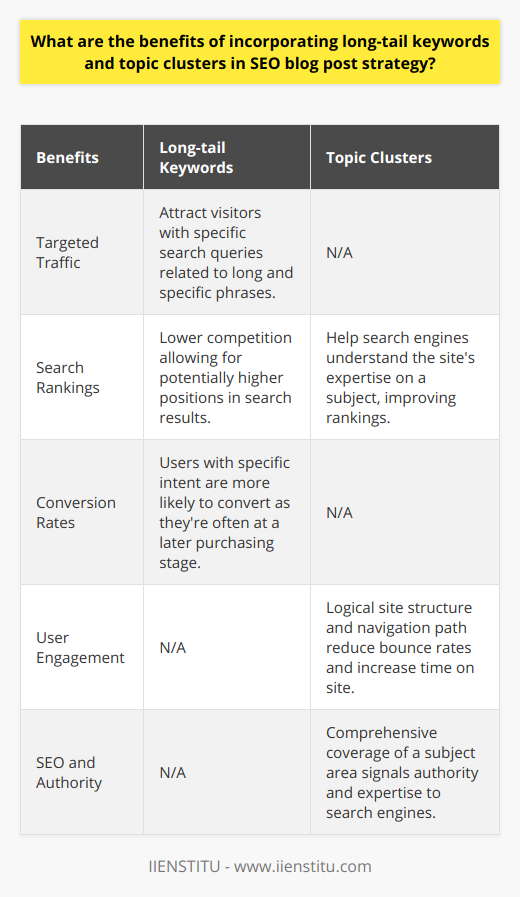
Search engine optimization (SEO) is the process of affecting the visibility of a website or a web page in a search engine's unpaid results—often referred to as "natural," "organic," or "earned" results. In general, the earlier (or higher ranked on the search results page) and more frequently a site appears in the search results list, the more visitors it will receive from the search engine's users.
SEO may target different searches, including image searches, local searches, video searches, academic searches, news searches, and industry-specific vertical markets. In addition, SEO differs from local optimization. The latter is focused on optimizing a business' online presence so that its web pages will be displayed by search engines when a user enters a local search for its products or services. The former, instead, is more focused on organic, long-term results.
Keywords researched and selected for SEO consideration should be evaluated against each of these variables. Where necessary and possible, elements should be altered to present a strong case that the given keywords represent an opportunity for that specific business.
Content is king, and better content means higher rankings, which ultimately means more traffic to your site. That's why search engine optimization is all about generating and publishing awesome content that people want to read and share with others—like you! SEO helps take it one step further by optimizing each web page or post title, meta description, content, and headlines to improve visibility in search engines.
Blogging is a great way to generate traffic because most blogs are updated daily with fresh new content. Each time you post something on your blog, you create unique, indexed content that search engines can freely crawl without needing prior permission from the webmaster. A few of the most critical factors for achieving high rankings in the search engines are:
Optimizing Your Blog For SEO
When optimizing your blog for search, there are several tips you can use to help increase your blog's visibility. Begin by making sure that every post has its title tag and meta description. Next, use short keywords or phrases since some crawlers may truncate long titles, and make sure to use keywords naturally.
Take the time to write unique, high-quality posts and provide the information your readers want for future reference. You should also help search engines understand what your posts are about by including a keyword or two in your title tag, image names, and alt text whenever possible. Finally, to give each post an extra boost in the rankings, you can create a unique page for each post, which is the practice some people choose to use on their sites.
This makes more sense when you have several posts about more than one topic and give more weight to that particular post. For example, instead of having one home page with multiple positions that all hold the same value, you might create a separate page or category for each post. That will allow you to rank various pages relevant to the same topic rather than diluting your rankings by having several posts with similar keywords on one page.
Since you want all your content to be easy to find, it's a good idea to invest some time into organizing things like categories and tags so visitors can easily navigate through your posts. It also makes it easier for crawlers to index specific topics on your site. Ensure that any links are built properly by reviewing your internal linking structure.
Last but not least, it's essential to update your blog frequently so search engines can crawl new content more often. Consistently publishing several fresh, recent posts every week can exponentially increase your blog's visibility. Suppose you want to take it one step further. In that case, you can submit your blog for consideration on sites like Blog Rankings or Listorious that provide lists of top blogs by category and subcategory.
The most important thing to remember is that if you want traffic from the search engines, make sure to take the time and build your blog up from the ground floor with quality content targeted at a specific audience. That way, when people find your site, they'll keep coming back for more!
The Importance of Keywords in Blog Posts
Keywords are words or phrases that describe a blog post. In the past, they were primarily used to direct search engines towards specific blog posts. However, with the advent of social bookmarking websites such as Digg and StumbleUpon, keywords have also become an increasingly important factor in driving traffic to your blog; people tend to search for keywords directly on these websites. Knowing this should encourage you to use keywords in your blog posts consistently.
While there are many different types of keywords, webmasters usually come up with two major categories: long-tail and head terms. Long-tailed keywords consist of more than one word, while head terms usually only comprise one word. So, for example, "keyword research" is a long-tail term, while "keyword" is considered the head term.
SEO is a powerful way to direct search engine traffic towards your website. One of the main reasons people start their blogs is to have better "hits" on Google or better page rankings, which means more visitors to their websites.
Getting your blog ranked high on the search engines is a complex task, however; you need to make sure that your blog posts contain valuable information and are written well—but having valuable content isn't enough because there are thousands of other blogs out there with pretty much the same topic as yours. For this reason, you need to learn how to get the most out of keywords. For that, you can join IIENSTITU’s SEO course for free.
An example of a long-tail keyword would be: "red shoes for women under $100."
This is more specific than simply using the term "shoe," Therefore, it will help you rank higher on Google. Many people use long-tailed keywords because they have more search volume, and you should too—the results will speak for themselves!
Steps For Improving Your Blog Post's Rank On Google SERP
Use specific keywords to rank your blog post higher on Google search results pages. For example, if you're writing an article about the benefits of raising cats as pets, then include phrases like "raise" or similar words for people browsing through different sites with similar topics that will find yours more relevant than others.
The following steps are designed specifically so that every word counts:
1) Choose two-three high-level marketing terms (elevate critical thoughts).
2) Write generic overview sentences around each concept
3) Incorporate the keywords into the second paragraph.
4) Go back through your article, replacing several words with synonyms.
How Do You Know If Your Content Is Good Enough For Seo Purposes?
If you are looking for a quick way to know if your content is good enough, the answer may not be as straightforward. To get an accurate idea of how well-written and informative each piece of information on Google’s SERPs needs to be to achieve top rankings with their search engine optimization (SEO) techniques; they conduct several different tests that measure specific aspects such as relevant keywords or keyword density within sentences/paragraphs etc., but there isn't always time available when doing this process manually - which means us humans need some help!
There are two main rules when it comes to writing content for Google which you should be aware of:
Write the information you would want to come across if you were searching.
Make sure it is relevant and valuable, so the person reading the article doesn’t bounce off it straight away.
Include a lot of examples. This may help explain things better for people who don’t fully understand the subject matter but also helps Google determine what your article is about and how useful it is to searchers etc.
Keywords are essential! Make sure you include your keyword in the title, URL, H1 tag and make it look natural in the content - don’t stuff it in at every opportunity, or it will have no value to Google.
Make sure all content is high quality.No matter how great your article is. If you have misspelled words or bad grammar, it will reflect poorly on Google. On the other hand, people expect good writing when looking for information, so make sure yours doesn’t let them down!
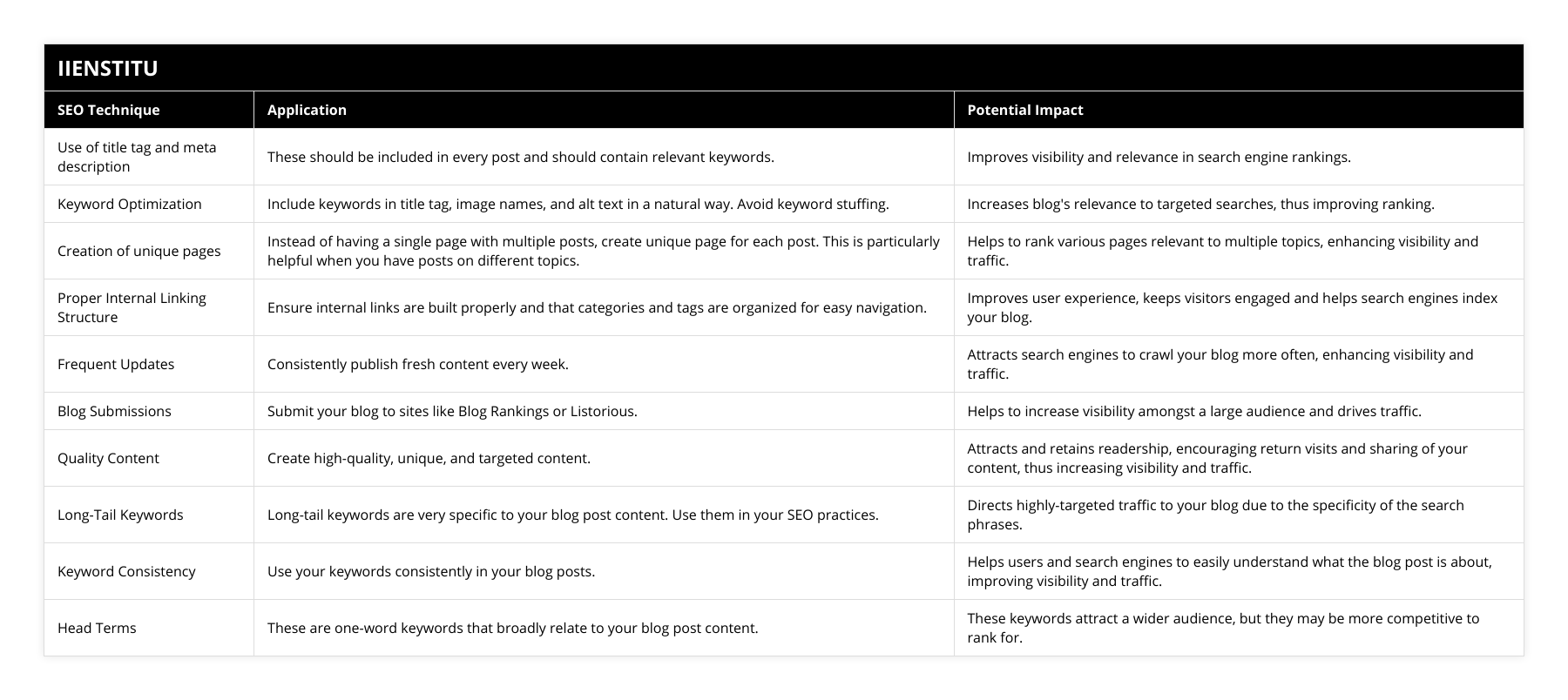
Frequently Asked Questions
How do I create an optimized SEO blog post?
Creating an Optimized SEO Blog Post
Understanding SEO Basics
To create an optimized SEO blog post, one must first understand the basic principles of search engine optimization (SEO). This includes conducting keyword research to identify competitive phrases, ensuring content usefulness and relevance, and adhering to SEO best practices.
Keyword Research and Usage
Begin by using keyword research tools, like Google Keyword Planner or SEMrush, to identify high-volume, low-competition keyword phrases relevant to the post topic. Once determined, strategically place the keywords throughout the content, especially in the title, headings, meta description, image alt tags, and body text. Be cautious, as overuse of keywords may appear as spam to search engines.
Focusing on High-Quality Content
Prioritizing high-quality, engaging content is crucial when optimizing a blog post. Construct content that answers user questions and provides valuable insights. This increases the likelihood of users spending more time on the page, decreasing bounce rates, and positively impacting SEO ranking. Investment in original, well-researched content improves user experience, further promoting sharing and online visibility.
Optimizing Headings and Meta Descriptions
For a well-optimized blog post, pay particular attention to headings and meta descriptions. Use an H1 title tag containing the primary keyword and separate sections using H2 or H3 subheadings with related keywords. Facilitating easier readability for users and search engines. Optimize the meta description with relevant keywords to summarize the blog post content, encouraging users to click on the search result.
Enhancing the Website's Load Speed
Faster page-loading speeds enhance the user experience and positively impact SEO. Optimize images by reducing their size without compromising quality, utilize caching plugins, and choose a suitable web host to reduce website loading time. These measures contribute to retaining user engagement on your blog post.
Incorporating Internal and External Links
Effectively implementing internal and external links in a blog post can augment SEO performance. Include internal links directing to other relevant pages within the website to deepen engagement and improve site navigation. Additionally, incorporate external links to authoritative sites, demonstrating content reliability and trustworthiness, further enhancing SEO optimization.
Conclusion
By following these critical steps, creating an optimized SEO blog post becomes achievable, increasing page visibility and making content more accessible to users. Ultimately, this empowers bloggers to strengthen their online presence and enhance the overall user experience.
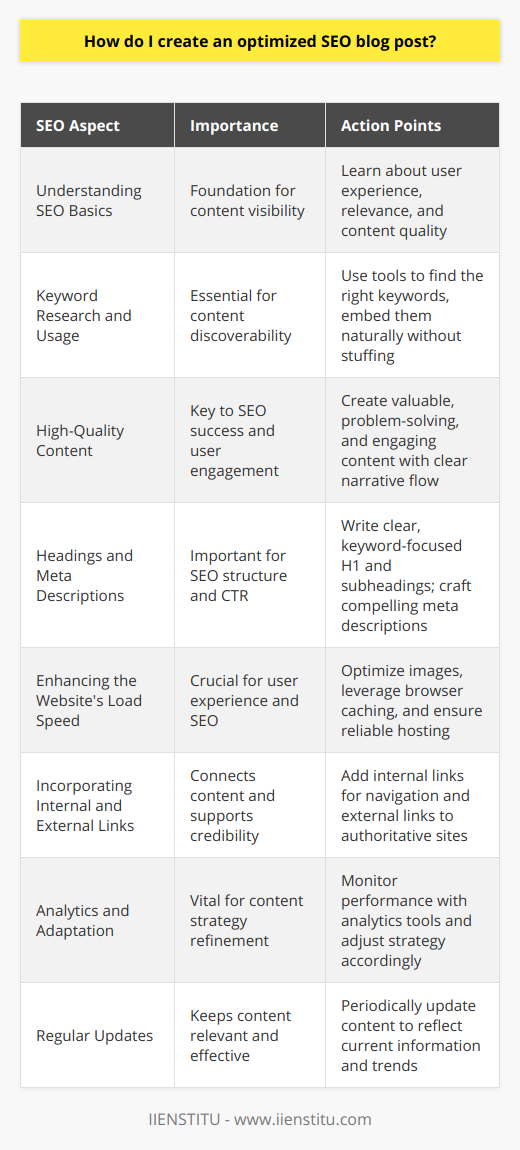
How many blog posts is good for SEO?
Optimal Number of Blog Posts for SEO
Effect of Posting Frequency
Striking a balance between quality and quantity is crucial for optimizing blog posts for search engine optimization (SEO). Studies indicate that posting more frequently can lead to a higher ranking and increased organic traffic from search engines (1). However, as an academic guideline, no specific number of blog posts can guarantee optimal SEO results as it largely depends on various factors.
Quality Over Quantity
Although numerous posts may improve SEO rankings, the primary focus should be on producing high-quality content that provides value to the reader (2). Consistently providing informative, engaging, and original content will resonate with audiences, leading to a higher probability of sharing the content and a natural increase in backlinks (3). Moreover, search engines tend to favor websites containing well-researched, in-depth articles with relevant keywords, proper formatting, and user-friendly readability.
Understanding the Audience
Understanding and catering to the target audience's preferences is vital when determining the ideal blog posting frequency. Metrics such as bounce rates, audience engagement, and average time spent on page can inform blogging strategies, indicating when the audience is engaged or when the posting schedule may require adjustments (4). Additionally, monitoring Google Analytics and incorporating feedback from the audience can prove beneficial in fine-tuning the blog’s content strategy.
Competitor Analysis
Analyzing the blogging frequency and content quality of competitors can enable website owners to gain insightful information about the industry's blogging landscape. Examining successful industry-specific blogs can help establish a benchmark for posting frequencies and content styles, ultimately aiding in designing an effective blogging strategy that addresses the audience's needs and preferences (5).
In Conclusion
To sum up, there is no definitive answer to the optimal number of blog posts for SEO. However, prioritizing the quality of the content, understanding the audience, and conducting competitor analysis can aid in formulating a blogging strategy that maximizes SEO benefits. The key lies in continuously assessing and refining the strategy to ensure that the blog maintains relevance and continues to enhance organic traffic growth.
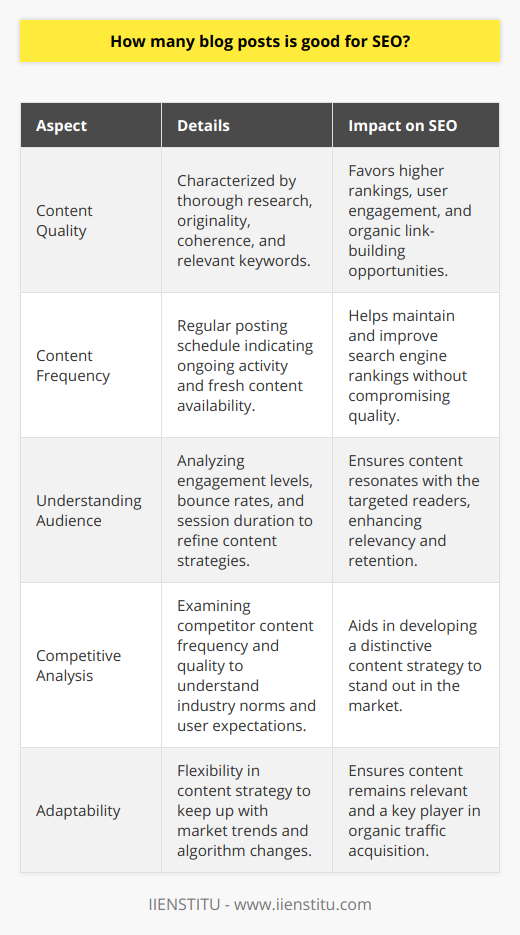
How many blog posts a day for SEO?
Optimal Blog Post Frequency for SEO
Daily Posting
A prevalent question among bloggers is the optimal number of blog posts per day for maximizing search engine optimization (SEO). On average, posting one high-quality, well-researched article per day yields the most significant SEO benefits.
Quality vs. Quantity
However, focusing solely on the number of blog posts poses a risk to content quality. Instead of prioritizing post frequency, bloggers should concentrate on creating valuable, engaging, and relevant content for their target audience. High-quality content increases the likelihood of being shared, linked, and establishing a strong online presence.
Keyword Research
To enhance SEO, bloggers must incorporate well-researched keywords into their content. Identifying and using appropriate keywords and phrases that align with the target audience’s search queries increase the blog’s visibility on search engines.
Interlinking
Another essential aspect of SEO is interlinking within blog posts. Linking to other relevant articles on the same blog enhances the user experience and increases the blog’s overall SEO value. This practice helps in creating a network of valuable content that search engines can easily crawl and index.
User Experience and Engagement
Regardless of how many blog posts one publishes daily, maintaining a visually appealing layout and superb user experience is vital. Blogs with poor navigation, slow loading times, and difficult-to-read content will discourage visitors from returning and negatively impact the site's SEO.
In conclusion, while aiming for at least one blog post per day enhances a blog's SEO, prioritizing content quality, proper keyword usage, interlinking, and improving user experience are equally important strategies for optimal SEO results.

What is the ideal length for an SEO-optimized blog post?
Ideal Length for an SEO-Optimized Blog Post
Determination of Optimal Length
The ideal length of a search engine optimized (SEO) blog post is a crucial factor in attracting readers and increasing website traffic. While there is no universally agreed-upon length, evidence suggests that the optimal word count is between 1,000 to 2,000 words (Sweor, 2020). This range caters to the needs of both search engines and human readers.
Balancing Search Engines and User Experience
Google and other search engines prioritize longer, in-depth content that provides valuable information (Patel, 2021). Blog posts with word counts in the aforementioned range tend to rank higher in search engine results, as they are perceived to offer comprehensive insights. However, exceptionally long posts may deter some readers due to a lack of conciseness and the potential for information overload (Brandon, 2019). Therefore, striking a balance between search engine preferences and user experience is key.
Readability and User Engagement
In addition to word count, the readability of a blog post significantly affects user engagement (Brown, 2020). Employing bullet points, subheadings, and paragraphs of no more than 20 words per sentence improves readability and facilitates understanding. Furthermore, employing simpler language and avoiding passive voice contributes to a more reader-friendly experience (Brown, 2020).
Adjusting Length According to Topic
While the ideal length of an SEO-optimized blog post typically falls between 1,000 to 2,000 words, it is vital to consider the relevance of the topic and the audience's interests (Turner, 2021). In some instances, shorter or longer articles may be more appropriate, provided they maintain readability and user engagement. Therefore, adjusting the length of a blog post to fit its content and target demographic is essential for achieving optimal results.
In conclusion, determining the ideal length for an SEO-optimized blog post involves balancing the preferences of search engines and users, enhancing readability, and adjusting the length based on the topic and audience. By adhering to the suggested range of 1,000 to 2,000 words and following best practices, bloggers increase their chances of attaining higher search engine rankings, boosting website traffic, and providing a satisfying user experience.
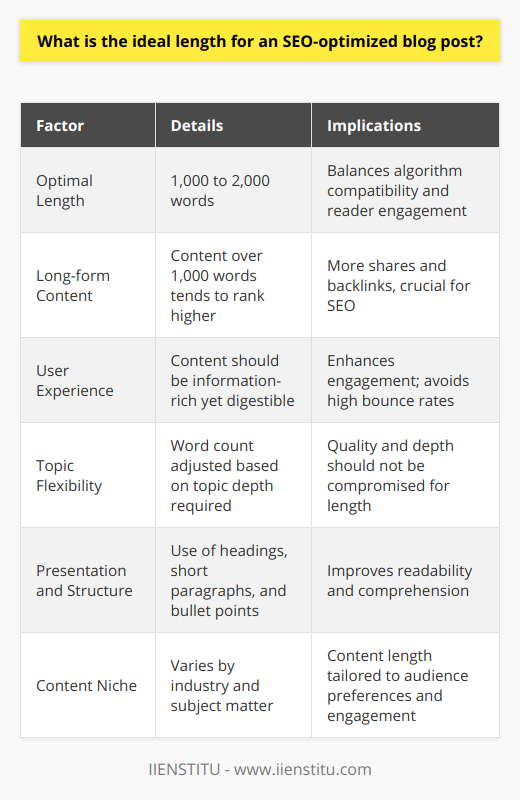
Which on-page factors are crucial for successful SEO blog post performance?
Crucial On-page Factors for Successful SEO Blog Post Performance
Keyword Selection and Placement
One of the most crucial factors for successful SEO blog post performance is the selection and placement of relevant keywords. Keywords provide a clear signal to search engines about the content of the blog post, and their judicious use in the title, headings, and body of the post can significantly improve search engine rankings.
Content Quality and Readability
Another critical factor in ensuring SEO success is the quality and readability of the content itself. Blog posts that are well-written, informative, and engaging will not only attract a higher number of visitors but also keep them on the site longer, thus reducing bounce rates and leading to better search engine rankings.
Optimized Meta Descriptions and Tags
The meta description and meta tags play a significant role in improving the blog post's SEO performance. A well-crafted, enticing meta description will entice users to click on the search result, while relevant meta tags provide context to search engines about the content.
Mobile Responsiveness and Page Load Speed
The majority of internet users browse websites on mobile devices, making mobile responsiveness essential to SEO success. Ensuring that a blog post is easily readable on various devices and screen sizes leads to higher user satisfaction and improved search engine rankings. Additionally, fast page load speeds have become a critical ranking factor, as slow-loading pages can lead to user frustration and increased bounce rates.
Internal and External Linking
Strategically placing internal and external links within blog posts can significantly enhance SEO performance. Internal links help guide users to other relevant content on the website, reducing bounce rates and increasing dwell time. External links to authoritative sources, such as research papers or industry leaders, add credibility to the blog post and can improve its ranking on search results.
Image Optimization and Alt Text
The use of optimized images and descriptive alt text is another crucial on-page factor for SEO. Optimized images contribute to faster page load speeds and better user experience, while informative alt text provides context for search engines and aids in image search results.
In conclusion, the key on-page factors contributing to successful SEO blog post performance include keyword selection and placement; high-quality, readable content; optimized meta descriptions and tags; mobile responsiveness and fast page load speeds; strategic internal and external linking; and image optimization with descriptive alt text. Implementing these strategies will ensure that your blog post ranks higher in search engine results, attracting more traffic and ultimately achieving your SEO goals.
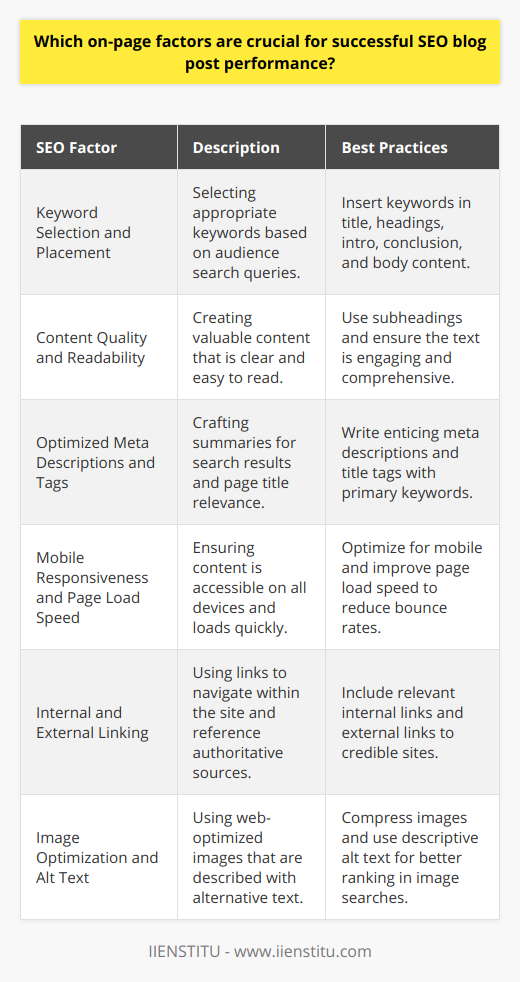
What role does keyword research play in drafting an effective SEO blog post?
Role of Keyword Research in Blog Posts
Identifying Target Audience
Keyword research plays a crucial role in drafting effective SEO blog posts by helping writers establish a strong connection with their target audience. By understanding the search queries that the audience uses, content creators can tailor their writing to match the readers' needs and expectations.
Driving Organic Traffic
Implementing keywords that accurately reflect the content allows search engines to recognize and index the blog post, thereby making it more discoverable. This, in turn, boosts organic traffic and improves the post's overall search engine ranking, ultimately increasing visibility and attracting more visitors.
Enhancing User Experience
A well-researched keyword strategy contributes to a better user experience by producing content that is relevant, informative, and engaging to the reader. When visitors find answers to their queries efficiently and effectively, they are more likely to stay on the page and explore additional content, reducing bounce rates.
Selecting Appropriate Topics
By studying trending and high-demand keywords, blog post writers can identify and prioritize topics that are both interesting and relevant to their target audience. This not only helps to maintain a loyal readership but also fosters a positive reputation for providing valuable and timely content.
Optimizing Blog Post Structure
Incorporating keywords strategically throughout the blog post, such as in headings, subheadings, and meta descriptions, allows for better overall optimization. This ensures that the content remains relevant to the target audience while also adhering to best practices for SEO.
Leveraging Long-Tail Keywords
Employing long-tail keywords, which are more specific and often less competitive, helps to target niche audiences, increasing the likelihood of higher conversion rates. Utilizing long-tail keywords enables content creators to cater to the specific needs and interests of a particular segment, setting the blog apart from more generalized content.
In conclusion, conducting thorough keyword research is an essential aspect of drafting an effective SEO blog post. It facilitates the creation of engaging, relevant content that meets the needs of the target audience, optimizes discoverability through search engines, and contributes to a positive user experience.
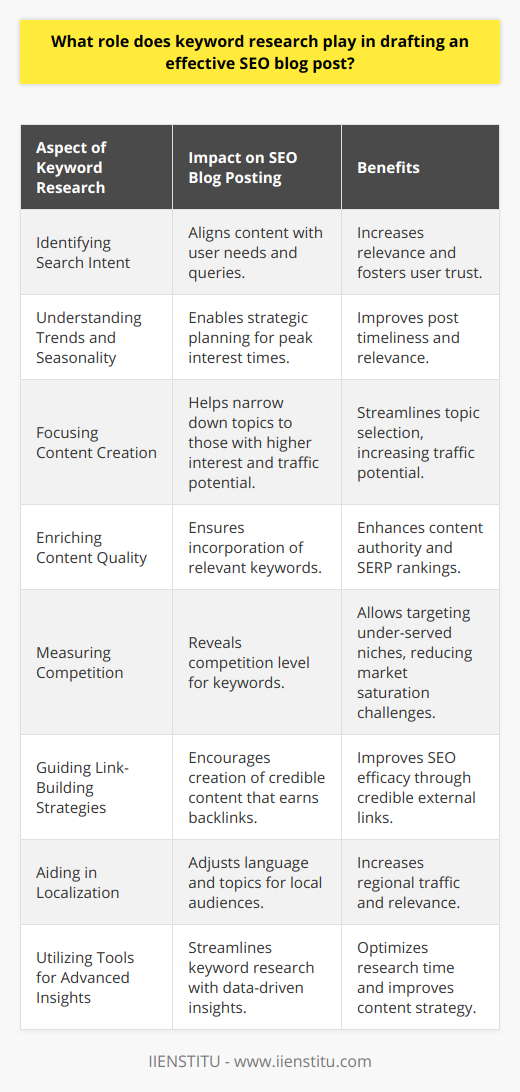
How do blogs improve SEO?
Impact of Blogs on SEO
Enhances Keyword Strategy
Firstly, blogs are instrumental in improving Search Engine Optimization (SEO) by expanding a website's keyword strategy. A diversified array of keywords used in blog posts increases the chances of search engines ranking the website higher, resulting in greater online visibility.
Boosts Website Indexing
Blogs also contribute to an increased rate of website indexing. Publishing regular, high-quality posts entices search engines to crawl and index the website more frequently. This ensures that new content is discovered quickly and ranks higher in search results.
Encourages Inbound Links
Moreover, blogs foster opportunities for generating inbound links or backlinks. When a blog post has valuable information, other websites may link to it as a reference. These backlinks are crucial for SEO, as search engines view them as votes of confidence and a measure of the content's quality.
Fosters Audience Engagement
Blogs facilitate audience engagement in the form of likes, shares, and comments. Engaging content helps attract and retain website visitors, signaling to search engines that the site provides valuable content. Consequently, search engines reward user-friendly websites with higher rankings.
Promotes Long-Form Content
In addition, long-form content is a potent tool for improved SEO. Blog posts that delve deeper into a topic tend to be lengthier than typical web copy, which is beneficial as search engines tend to prioritize longer content. Higher word count generally correlates with more opportunities for keyword optimization and user engagement, further optimizing the website for search engines.
Improves Time on Site Metrics
Lastly, well-written blog posts encourage visitors to spend more time on a website, positively impacting time on site metrics. Search engines use these metrics to gauge user satisfaction, which influences the overall SEO score. In essence, higher user satisfaction leads to better search rankings.
In conclusion, blogs are an essential component of any successful SEO strategy. They improve a website's keyword range, increase indexing frequency, foster inbound links, drive audience engagement, and promote long-form content while boosting time on site metrics.

What are the best practices for incorporating internal and external links in SEO blog posts?
**Appropriate Anchor Text**
One best practice for incorporating internal and external links in SEO blog posts is using appropriate anchor text. Anchor text is the clickable text in a hyperlink, usually related to the linked page's content. Ensure that the anchor text is concise, relevant, and accurately represents the linked content. Avoid using generic phrases like 'click here' or 'learn more,' as these do not provide a clear context for the link, reducing its SEO value.
**Strategic Link Placement**
Placing links strategically throughout the blog post is vital for maximizing the SEO benefits. Incorporating links within the first few paragraphs will provide an opportunity for users to explore other resources while still reading the introduction. Additionally, integrating links consistently and contextually throughout the content can help keep the post natural and keep users engaged in exploring further.
**Balanced Link Ratio**
Maintaining a balanced internal and external link ratio is essential for optimal SEO performance. While internal links help inform the search engine about the structure and relevance of internal pages, external links to authoritative sources enhance the credibility and trustworthiness of the blog post. Including only internal or external links may result in reduced effectiveness, making it crucial to maintain a balance between the two types of links.
**Relevant and Authoritative Sources**
When incorporating external links, it is crucial to link to relevant and authoritative sources. Linking to reputable websites with established domain authority will add greater value to the blog post from an SEO perspective. This practice also demonstrates to users that the content is well-researched, accurate, and reliable.
**Optimization for User Experience**
Always consider the user experience (UX) when incorporating links into blog posts. Ensure that the linked resources genuinely contribute to the reader's understanding or knowledge of the topic. Overloading the blog post with excessive or irrelevant links can lead to poor UX, ultimately resulting in lower search engine rankings.
**Regular Link Maintenance**
Regularly checking and updating blog posts for broken or outdated links is another best practice for incorporating internal and external links in SEO blog posts. Broken links not only harm the blog post's credibility and user experience but also negatively impact the search engine ranking. Regular maintenance ensures that the links continue to provide value to users and maintain the post's SEO effectiveness.
Incorporating internal and external links following these best practices will help improve the visibility, credibility, and user experience of SEO blog posts, resulting in higher search engine rankings and better overall performance.
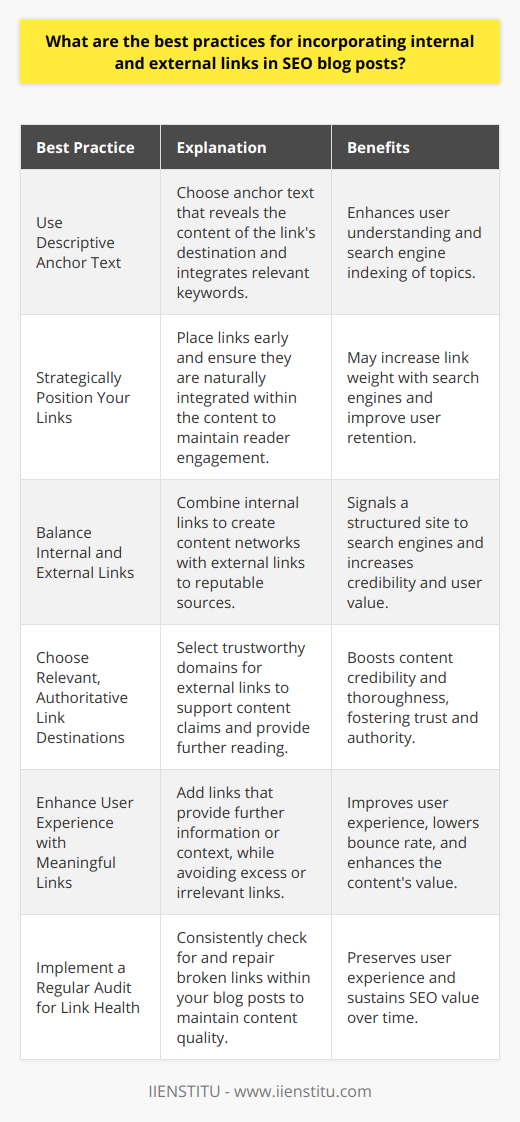
How can content creators use multimedia elements to enhance the SEO value of their blog posts?
Utilizing Multimedia Elements in Blog Posts
**Incorporating Visual Content**
To enhance the SEO value of blog posts, content creators should prioritize incorporating visual elements, such as images and videos. These visuals can be informative, entertaining, or both, making them engaging for the reader while also providing search engines with additional information about the post's subject matter, relevance and value.
**Optimizing Image Alt Tags and Titles**
Another strategy for maximizing the SEO benefits of multimedia is to include optimized image alt tags and titles. Alt tags provide a description of the image's content for search engines, enabling better indexing and ranking. Likewise, image titles can contribute to the overall keyword targeting of the post, improving its searchability and click-through rate.
**Integrating Relevant Keywords**
When embedding multimedia elements, it is critical to ensure that they are properly labeled and categorized with relevant keywords. This includes using correct file names for images and videos, as well as incorporating these keywords into the caption text. Integrating keywords into multimedia content can boost the blog post's overall SEO performance.
**Leveraging Embedded Social Media Content**
In some cases, integrating embedded social media content within blog posts can significantly contribute to their SEO value. A strategically placed tweet, Instagram post, or Facebook update that relates to the post's subject matter can attract additional traffic from social media platforms while lending credibility and authority to the content. Consequently, this can result in higher search engine rankings.
**Structured Data and Rich Results**
Utilizing structured data markup and implementing rich results also offer content creators the opportunity to enhance their blog posts' SEO value. By incorporating different types of multimedia content, such as videos, infographics, and interactive elements, and labeling them accordingly with structured data markup, search engines can better understand and display the information. This, in turn, can lead to higher click-through rates and better rankings in search engine result pages.
In conclusion, content creators can effectively use multimedia elements to improve the SEO value of their blog posts by incorporating visual content, optimizing image alt tags and titles, integrating relevant keywords, and leveraging embedded social media content. Additionally, implementing structured data markup and rich results allows for a well-rounded SEO strategy that taps into the full potential of multimedia elements in blog post optimization.
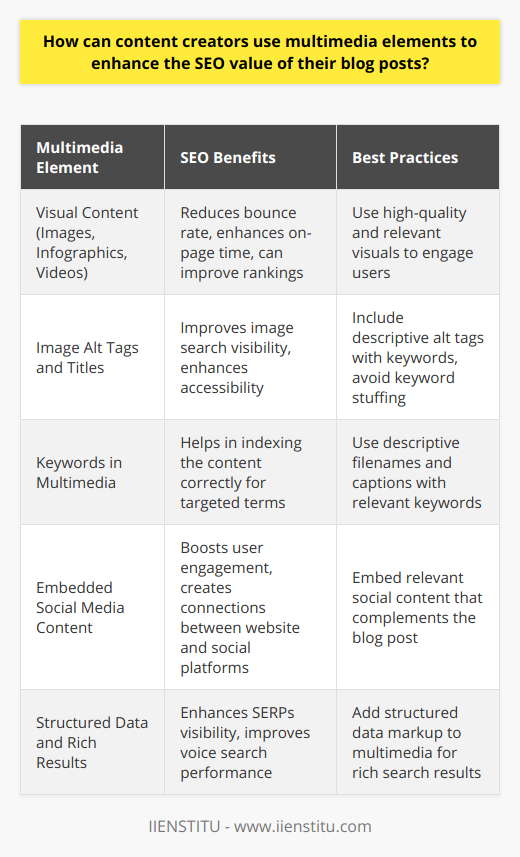
How do I make my blog post SEO optimized?
Understanding SEO Optimization
To make a blog post SEO optimized, it is essential to consider several key factors, including keyword research, content quality, and user experience. These factors contribute to increasing the visibility of the blog post on search engine results, driving more organic traffic to the website, and ultimately improving its overall ranking.
Keyword Research and Selection
Initiating the process with keyword research ensures that the blog post targets the right audience and meets their search queries. Utilize reputable keyword research tools, such as Google Keyword Planner, to identify relevant keywords with high search volume and low competition. After selecting appropriate keywords, incorporate them strategically within the blog post, such as in the title tag, meta description, and headings.
Content Quality and Relevance
Ensuring that the blog post contains high-quality, informative, and relevant content is essential for SEO optimization. Google's algorithms, especially the recent updates like BERT, prioritize content that offers value to users and addresses their needs effectively. Thus, focusing on creating clear, concise, and engaging content is crucial to attain a higher ranking on search engine results pages (SERPs). Implementing original ideas, providing accurate information, and using a conversational tone is recommended to increase overall content quality.
User Experience and Readability
Optimizing user experience and enhancing readability significantly contribute to boosting a blog post's SEO ranking. Pay attention to formatting the content with shorter sentences, using simpler words, and dividing the text into smaller sections with subheadings. This practice enhances accessibility and readability, making it more likely for visitors to spend more time on the website and share the content on social media platforms. Additionally, optimize the page load speed and mobile responsiveness of the website to retain users' interest and minimize bounce rates.
Internal and External Linking
Incorporating internal and external links within the blog post is an excellent strategy to improve SEO ranking. Linking to reputable external sources increases the credibility and authority of the content, while internal linking helps users navigate through the website and find related content more easily. Both practices encourage users to engage further with the content and facilitate search engines in understanding the context and value of the blog post.
In conclusion, ensuring that a blog post is SEO optimized requires a comprehensive approach, including keyword research, content quality, user experience, and strategic linking. Implementing these practices effectively results in higher visibility on search engine results, increased organic traffic, and improved overall ranking.

How many blog posts is good for SEO?
Optimal Blog Post Frequency for SEO
Number of Blog Posts
Regarding the ideal number of blog posts for Search Engine Optimization (SEO), there is no exact answer that applies to every situation. However, experts generally recommend posting at least twice a week for optimal results. Regular content production can increase website traffic, encourage engagement, and offer search engines fresh resources to index. However, there are several factors to consider when determining a suitable posting frequency for SEO purposes.
Quality Over Quantity
Content quality is of paramount importance when considering the number of blog posts required for effective SEO. High-quality and unique content aids in attracting organic traffic and enticing readers to stay on the site longer, hence improving its overall performance. If the production volume affects the content's quality, it might be prudent to reduce the number of posts while ensuring each piece is engaging and valuable to the audience.
Target Audience and Competition
Understanding one's target audience and competition is fundamental in determining the appropriate frequency of blog posts. The niche one operates in, the preferences and expectations of their target audience, and the competitors' posting frequency will undoubtedly influence the decision. Conducting thorough research on these factors can help arrive at an optimal posting schedule, tailored specifically to the needs of the audience and the nature of the niche.
Resources and Capacity
Lastly, it is crucial to consider a blog's resources and capacity when deciding on the number of posts. This includes the availability of skilled content creators, budget constraints, and other factors that might affect content production. Ultimately, it is essential to strike a balance between producing sufficient content to maintain visibility in search engine results and ensuring that quality remains consistent.
Conclusion
In conclusion, there is no one-size-fits-all answer to the ideal number of blog posts for SEO. Factors such as content quality, target audience and competition, and availability of resources all play a part in determining the optimal posting frequency. The key is to find a balance that allows for regular content updates without compromising the quality and relevance of the posts.

How many blog posts a day for SEO?
Optimal Blog Post Frequency for SEO
Determining the Ideal Quantity
Search engine optimization (SEO) plays a critical role in driving organic traffic to a website. When it comes to blogging, determining the right number of daily blog posts to maximize SEO is essential. However, there is no one-size-fits-all answer as the optimal number varies depending on factors such as niche, target audience, and competition.
Quality vs. Quantity
Though it might be tempting to flood the website with daily blog posts to gain higher visibility, the quality of the content should never be compromised. Google's algorithms have evolved to prioritize high-quality, relevant, and user-friendly content. It is crucial to focus on creating well-researched, engaging, and share-worthy posts that provide value to the readers instead of churning out low-quality, keyword-stuffed content.
Considering Resources
The optimal number of blog posts per day also depends on the available resources, including time, budget, and personnel. Investing in a higher volume of blog posts requires commitment and dedication, and it may not be feasible for bloggers or small businesses operating with constrained resources. In such cases, a strategic approach involving producing fewer, but higher-quality blog posts might prove more beneficial.
Assessing Competition and Niche
Understanding the level of competition and niche-specific demands is crucial in determining the right frequency. Examining the practices of successful competitors and identifying any content gaps can help craft a tailored blog posting strategy. For specialized niches or industries with less competition, a lower frequency of blog posts may suffice, whereas for highly competitive niches, posting multiple times a day might be helpful in gaining a competitive edge.
Adjusting Posting Frequency Over Time
As with any digital marketing strategy, evaluating the effectiveness of blog post frequency is crucial. The data obtained through analytics can be leveraged to identify trends, make necessary adjustments, and track improvements in search engine rankings and organic traffic. It is advisable to remain open to refining the posting strategy based on observed results and growth objectives.
In conclusion, there isn't a definitive number for the ideal blog post frequency for SEO, as it is contingent on factors like niche, competition, and available resources. Ultimately, striking a balance between quality and quantity while being flexible and adaptive to changing trends is the key to maximizing the impact of blog posts on SEO.
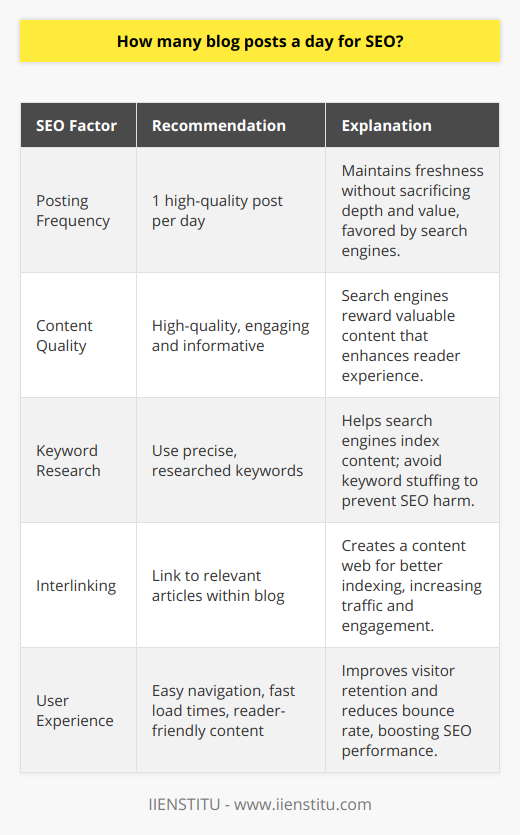
How can the use of headings and subheadings improve the SEO of a blog post?
Enhancing SEO through Headings and Subheadings
Structure and Hierarchy
Headings and subheadings inherently provide a structure and hierarchy to a blog post. Search engines prioritize well-organized content to deliver a better user experience. The adoption of a clear hierarchy effectively enables search engines, such as Google, to understand the blogger's main topics and subtopics.
Keyword Targeting
Incorporating relevant keywords in headings and subheadings boosts blog posts' SEO. Keywords should be strategically placed, specifically in the H1, H2, and H3 tags. This technique allows search engines to recognize and rank the blog post for those targeted keywords. As a result, search engine users can discover the content more easily.
Content Accessibility
An organized blog post promotes accessibility and audience engagement by enabling readers to easily navigate content according to their needs. Headings and subheadings act as signposts, guiding readers through the post and, consequently, increasing the chances that they stay on the page longer. This increased time spent on the page signals search engines that the content is valuable, which positively impacts the blog post's SEO.
Semantic Relationship
The use of H1, H2, and H3 tags plays a vital role in creating semantic relationships between different sections of a blog post. These relationships help search engines understand how different pieces of content are connected within the post. Consequently, search engines can more accurately index the post, resulting in better search engine rankings.
Conclusion
In summary, effectively utilizing headings and subheadings improves the SEO of a blog post by providing structure, prioritizing keyword targeting, promoting accessibility, and establishing semantic relationships. Employing this strategy can greatly enhance a blog's search engine ranking and visibility, increasing its chances of reaching a wider audience.

What is the importance of meta descriptions and title tags in SEO-optimized blog posts?
Significance of Meta Descriptions
Meta descriptions play a crucial role in enhancing the visibility of blog posts on search engines, effectively drawing in potential readers. These brief snippets provide a concise summary of the content, enabling users to discern the relevance of the blog post to their search queries. As an essential component of SEO optimization, well-crafted meta descriptions can increase click-through rates and contribute to higher search engine rankings.
Role of Title Tags in Blog Posts
Title tags, on the other hand, serve as the headline of a blog post on search engine result pages (SERPs). They inform users and search engines about the central theme of the content. An informative and captivating title tag is likely to attract more clicks, potentially boosting a blog post's SEO performance. To optimize title tags for SEO, it is crucial to incorporate relevant keywords that resonate with the target audience's search queries.
Enhancing User Experience
Both meta descriptions and title tags impact the user experience by clarifying the content's relevance for users. Providing accurate and engaging descriptions ensures that users access content that meets their needs, fostering a positive browsing experience. Consequently, the user's satisfaction is likely to translate into longer site visits, lower bounce rates, and higher user engagement, which, in turn, can improve the blog's overall search engine ranking.
Contributing to Search Engine Ranking Factors
Search engines utilize meta descriptions and title tags to gauge the relevance and quality of a blog post to specific search terms. These elements form a part of the search engine algorithms that determine search engine rankings. By incorporating relevant keywords and crafting attention-grabbing descriptions, blog writers increase the likelihood of achieving higher rankings on SERPs, thereby enhancing the post's visibility and driving more organic traffic to the blog.
In conclusion, meta descriptions and title tags are of paramount importance for blog posts aiming to optimize their SEO performance. These elements contribute to the visibility of the blog on SERPs, attract potential readers, enhance user experience, and directly influence search engine ranking factors. As such, blog writers should prioritize the creation of well-crafted meta descriptions and title tags to maximize the effectiveness of their content in the highly competitive digital space.
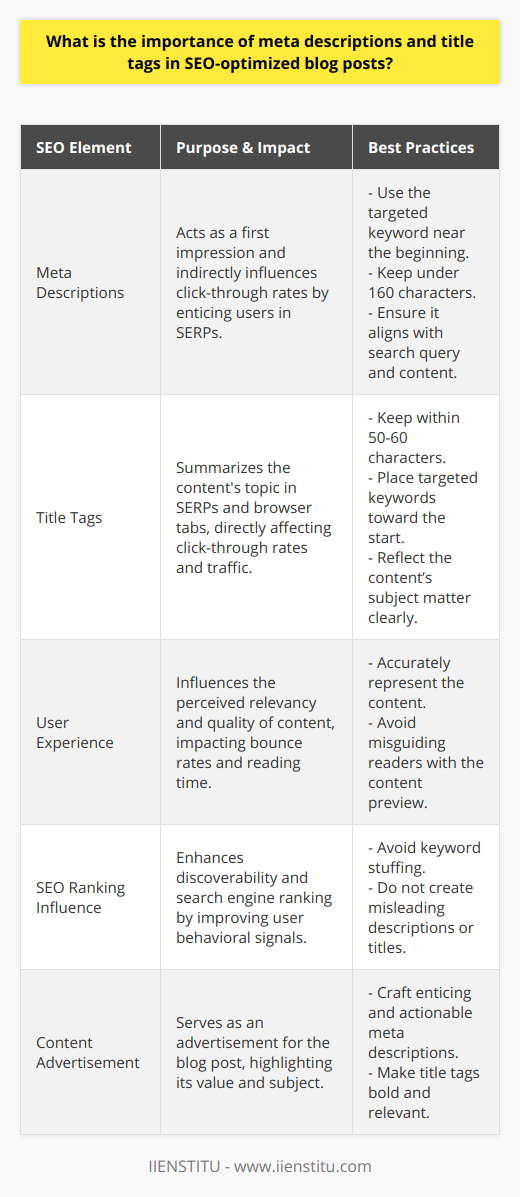
How can focusing on readability enhance the SEO value of a blog post?
Enhancing SEO Value Through Readability
A focus on readability can enhance the SEO value of a blog post by addressing several factors that influence search engine algorithms. Readability is a key aspect of user experience, which directly impacts the visibility and ranking of a website on search engines like Google. By employing simple language, concise sentences, and relevant subheadings, a blogger can effectively improve readability and thus elevate SEO value.
User Experience and Search Engines
Search engines aim to deliver the best possible user experience to their users, and they do this by constantly evolving their algorithms. A blog post that prioritizes readability ensures that the content is easily understood by the target audience, which can lead to improved user satisfaction. Satisfied users are more likely to share the content with others, attracting more traffic to the website, and ultimately increasing the blog's search engine visibility.
Simple Language and Concise Sentences
Using simple language and concise sentences can make the blog post more accessible to a broader readership. Search engines' natural language processing algorithms have been designed to comprehend and analyze text much like humans do. Therefore, by ensuring that the content is uncomplicated and easy to understand, the blogger enhances the likelihood of the post being ranked higher in search engine results pages (SERPs).
Relevant Subheadings
Incorporating relevant subheadings into a blog post can improve its readability by providing a clear structure and organization for the content. Subheadings not only guide readers through the text but also help search engines understand the hierarchy and importance of different sections within the post. Utilizing keyword-rich subheadings can further optimize the content for search engines, as they often consider the use of such terms as an indication of the post's relevance to a particular topic or query.
In conclusion, focusing on readability can significantly enhance the SEO value of a blog post by optimizing it for user experience and increasing its visibility in search engine results. By using simple language, concise sentences, and relevant subheadings, bloggers can create content that is more likely to be discovered, read, and shared by their target audience.
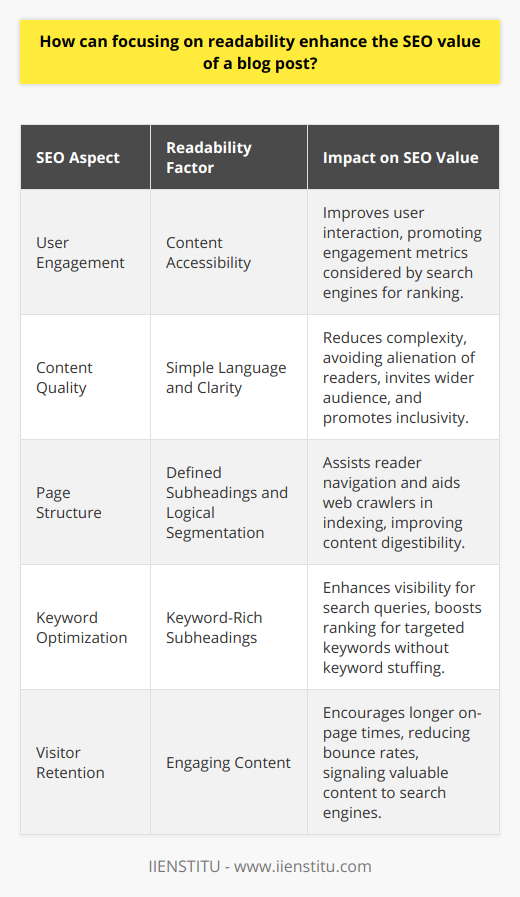
How can the appropriate use of keywords in a blog post contribute to its SEO optimization?
Enhancing the SEO Value through Keywords
Keywords play a pivotal role in optimizing the Search Engine Optimization (SEO) value of a blog post. They serve as the primary tool through which search engines recognize the post's content. When a user conducts a search, the search engine matches the keywords in the user's query to those in your content. By embedding these keywords in the right places, the blog post becomes more detectable to the search engines.
Significance of Keyword Placement
Effective placement of keywords amplifies the SEO value of a blog post. Including them in the post's title, meta description, headings, and throughout the body text enhances its visibility. It's also important to maintain keyword density; an overuse can lead to a penalty from search engines. Striking the right balance can optimize the blog post for maximum visibility.
Role of Long-tail Keywords
Long-tail keywords, which are more specific phrases, can increase the precision of match with user queries. They allow the blog post to rank higher for specific niche markets. Additionally, these types of keywords face less competition and can improve the blog post's ranking on search engine result pages.
Impact of Keywords on User Experience
While keywords optimize a blog post for SEO, they must also contribute positively to the user's experience. Proper use does not deter from the content flow and relevancy. Posts need to remain engaging and informative for the readers. Overdoing it can result in a negative user experience, affecting the post's SEO ranking negatively.
In conclusion, the appropriate use of keywords drive the SEO optimization of a blog post. They function as connectors between the content and its potential audience through search engines. Balancing keyword placement, utilizing specificity of long-tail keywords, and considering the user experience result in a well-optimized blog.

What strategies can be employed to maintain a consistent posting schedule to benefit SEO?
Content Planning and Regularity
A well-organized content calendar represents a primary strategy for maintaining a consistent posting schedule. By planning and designing content in advance, bloggers can manage their posting schedule more effectively. This proactive approach ensures timely and consistent content updates, a crucial factor in SEO performance.
Optimizing Time Management
Efficient time management also becomes critical. Allocating specific time for content creation and publishing can ensure consistency. Adherence to this schedule can facilitate regular content release, aligning the blog with the algorithmic preferences of search engines.
Automation Tools
Utilizing automation tools is another beneficial strategy. Scheduled posts can be automatically published at the intended date and time using these tools. This not only saves time but can also fulfill SEO requirements for regular updates.
Quality Over Quantity
However, regular content release should never compromise the quality of the posts. Quality content is more likely to attract sustained organic traffic, which is vital for higher SEO rankings. Hence, balance between quality and quantity of posts must be maintained.
Contextual Link Building
Lastly, integrating contextual link building in the posts can help in SEO. Adding relevant internal and external links enhance the user experience and offer additional value. It can also increase site visibility, thereby improving SEO performance.
In conclusion, consistent content release catalyzes optimal SEO performance. Strategies such as content planning, time management, use of automation tools, maintaining content quality, and contextual link building can be employed effectively for this purpose.

In what ways do social sharing and audience engagement impact the SEO performance of blog posts?
Effects of Social Sharing on SEO
Social sharing significantly impacts the SEO performance of blog posts. When a blog post gets shared across various social media platforms, it increases its visibility. This increase potentially draws more traffic to the post, thereby improving its SEO rank.
Role of Incoming Links
These shares also create multiple incoming links to your blog post. Incoming links from authoritative or popular websites boost the credibility of your blog. Search engines, such as Google, prioritize websites with numerous authoritative links, resulting in better SEO performance.
Influence of Engagement Metrics
In addition to social shares, audience engagement directly impacts a blog post’s SEO performance. Comments, likes, shares, and average visit duration are some engagement metrics that search engines consider. Higher engagement tends to signal that the content is valuable and relevant to the audience. This interpretation aids in improving the SEO ranking of the blog post.
Relation between Engagement and Content Quality
Engagement also indirectly influences SEO through content quality. Engaged readers are likely to consume more content, encouraging the blogger to produce high-quality material. Search engines favor high-quality, updated, and relevant content, which further boosts SEO performance.
The Impact of Social Signals
Finally, search engines use social signals, such as likes and shares, as indications of content relevance and quality. Greater social signals can lead to an improved SEO rank as they indicate the content is relevant and in-demand.
In conclusion, social sharing and audience engagement significantly improve a blog post's SEO performance. They not only increase visibility and credibility but also help create quality, relevant content that search engines value.

How long should an SEO optimized blog post be?
Ideal Length of an SEO-Optimized Blog Post
The Optimal Word Count
In the realm of Search Engine Optimization (SEO), content length plays a significant role. Longer blog posts, often between 1,000 to 2,000 words, typically perform better in search engine rankings.
Importance of Quality
However, the length is not the sole determinant. Quality matters just as much. Well-structured, meaningful, and relevant content is what attracts and retains readers.
Incorporating Longer Keywords
Moreover, longer blog posts provide opportunities to incorporate long-tail keywords. These can increase your chances of ranking higher in search results.
Balancing Length and Engagement
Nevertheless, you must strike a balance. Too long and readers may lose interest. Ideal blog content should be comprehensive yet engaging.
Breaking Content Down
In order to maintain readability, break your content down into sections. Use subheadings, bullet points, and images to enhance legibility.
Adjusting to Reader Preferences
Furthermore, the optimal length can vary based on the nature of your content and the preferences of your readers. Therefore, it is wise to conduct audience analysis and adjust accordingly.
In summary, while longer blog posts tend to fare better in SEO, they must remain engaging and relevant for optimal results. Thus, the length of a blog post, while important, is one aspect among many in a well-rounded SEO strategy.
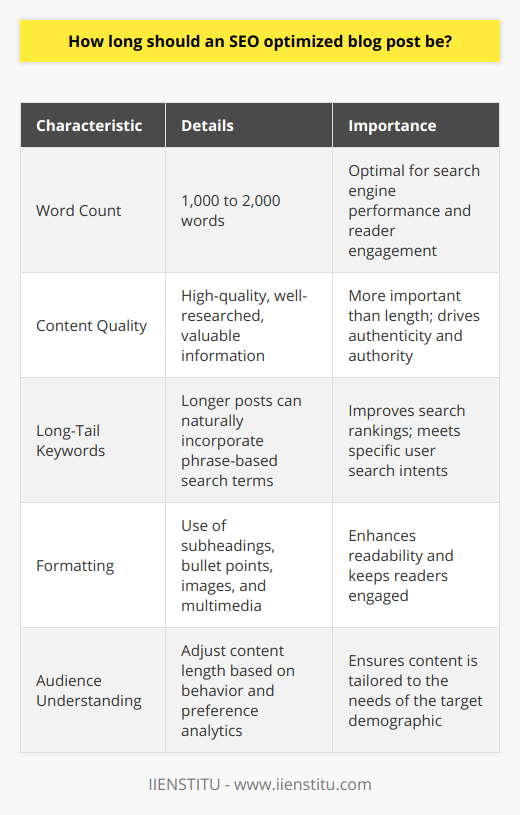
How do I know if my blog is SEO optimized?
Checking SEO Optimization of a Blog
To determine if a blog post is SEO optimized, start by examining the content quality. Unique, engaging content naturally improves SEO.
Keyword Usage
Investigate the keyword usage next. A targeted keyword should appear in the title, header tags, meta description, and throughout the content.
Meta Tag Evaluation
Evaluate the meta tags. These describe the content on your blog and are essential for SEO. They should incorporate your chosen keyword.
Image Optimization
Check the image optimization as well. Images should have descriptive file names and alt tags, and there should be optimal use of relevant images.
Internal and External Links
Inspect the internal and external links in the blog post. Hyperlinks to quality external sources, coupled with relevant internal links, improve SEO.
Usability
Assess the blog's usability. If the blog is user-friendly, with fast load times and a responsive design, it aids in SEO optimization.
Social Sharing
Lastly, the provision for social sharing aids in more visibility and thus, improved SEO.
By conducting this systematic analysis, you can conclude whether a blog is SEO optimized or not. The aforementioned methods combine both technical and non-technical aspects of SEO, providing not just a comprehensive SEO checklist but also a roadmap for improvement if needed.
Remember that SEO optimization is not static and demands continuous updates to reflect evolving search algorithms. Therefore, regular checks and tweaks are crucial to maintain the SEO health of your blog.

What are the benefits of incorporating long-tail keywords and topic clusters in SEO blog post strategy?
Enhancing SEO through Long-tail Keywords
One critical benefit of using long-tail keywords is increased website traffic. These specific search phrases directly target a blog's niche audience over broad terms. Due to their specificity, long-tail keywords outperform short, ambiguous phrases in search query relevancy. This results in a potential surge in organic traffic and improved search engine ranking.
Accuracy and Conversion Rates
Additionally, detailed keywords have a higher likelihood of matching user intent. Visitors searching with long-tail keywords are usually closer to a purchase decision. This alignment between the search intent and blog content enhances the probability of conversion. It elevates the potential of who visits becomes a paying customer, email subscriber or regular reader.
Reduced Competition in SERPs
Long-tail keywords also offer the opportunity to rank high in search engine results pages (SERPs). They tend to have lower competition compared to generic terms. The better you rank, the more you heighten your visibility in organic searches. This fact puts your blog at the forefront of search results and increases accessibility.
Importance of Topic Clusters in SEO
Creating topic clusters positively impacts SEO by showcasing a website's authority on a specific subject. Establishing subject-matter expertise enhances a blog's reputation in the eyes of search engines. Further, Google and other search engines reward such structured and linked content with higher SERP ranks.
Boosting User Experience
Topic clusters also improve user experience. They offer a structured way to navigate website content. This ease of navigation enhances user engagement, reduces bounce rate and increases time spent on the site. Such positive user engagement metrics further enhance SEO.
Lastly, the strategic interlinking in topic clusters keep users on your website for longer. It leads them through a planned journey based off their initial query. This increases page views per visitor, positively influencing SEO performance. Easy navigation backed by comprehensive content fosters loyalty amongst readership, building a dedicated visitor base over time.
In conclusion, leveraging long-tail keywords and topic clusters increase organic traffic, improve search engine ranking and enhance user experience. These factors contribute to a robust and successful SEO blog post strategy.
